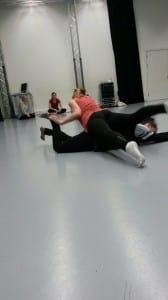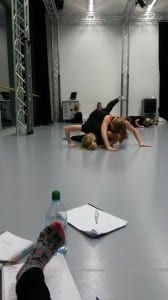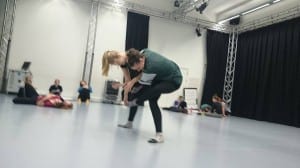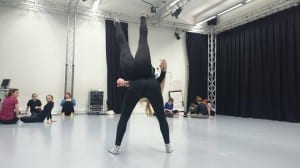This was my first research lab but the second that the class have done. I found it very interesting how problems that the group had, turned in to them progressing and becoming better at dancers. We started with exploring the use of speed and space within Contact Improvisation.
We first started with preamulation, just to warm the dancers up and to energize the space. After this we then looked at how space affects Contact Improvisation.
Space: Does varying the space help create fluidity?
Can you achieve fluidity when travelling?
How much does space influence your movement?
To get answers to these questions we started by working close to the floor, then moved on to a high level, then we mixed the levels and finally using mixed levels and how they were affected by travelling across the room and which level was easier to travel with. Watching the dancers on the lower level I started to see that the dancers didn’t vary their movements, they rolled over each other using there belly and back and as they weren’t allowed to stand up the improvisation became no varied
As a group we spoke about what we observed and how the dancers felt while dancing. We all agreed it was not varied and they used their backs and bellies as they found that the most comfortable when dancing on the floor. We then decided to repeat the lower level again with the knowledge we had discovered. This time it was better and the dances looked more comfortable as they used more body parts such as legs and arms. The piece became more exciting and interesting to watch.
We then tried the higher level and we found that again the dancers went to their comfort zone, these were the head, back and belly. I called this the safety net of the dancer as when they didn’t know what to do they went back to these 3 places and I also felt that they were two scared to try something new. The dancers agreed with our feedback. Again we repeated this exercise with the dancers thinking about changing their base by moving their feet, leaning and reaching with other and using their legs more as they were very static in the first exercise. With this the dance became more fluid, the dancers looked and felt more comfortable and said they felt they could experiment more and had gained confidence. 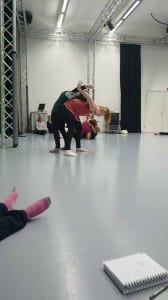 as you can see from the picture even though they were using their back Jade felt comfortable to lean on Alice and let Alice take her weight. After this we mixed the two levels together and from the beginning of the improvisation the dancers used the feedback and made the improvisation exciting to watch.
as you can see from the picture even though they were using their back Jade felt comfortable to lean on Alice and let Alice take her weight. After this we mixed the two levels together and from the beginning of the improvisation the dancers used the feedback and made the improvisation exciting to watch.
Next we looked at travelling across the space using both levels this was affective and again a safety net for the dancers appeared which was rolling across each other to travel when working on the lower level.
It was exciting and when both Kelly and Alice tried new movements out but still found themselves rolling to travel. We also found that it was linear travelling which could have been because of the space we had but we decided as a group to be aware of this.
From the questions we formed at the beginning varying the space can create fluidity within the piece if the dancer is willing to experiment and take risks with their partner. Fluidity was also found when travelling across the room as they used momentum and speed to travel which made the exercise flow, this lead us on to look at speed.
Speed: Does speed affect the quality of movement?
Can you still remain connected to your partner?
Can you still use momentum when moving slowly?
Can you vary the tonal qualities without altering the speed?
The dancers could use any level they wanted but for a start they could only move slowly but with a hard tone. From an audience perspective I could not tell that they were using a hard tone it looked like they were just moving slowly and not trying to change the tone, when speaking to the dancers they were surprised as they found it hard but said they could feel a resistance between their selves which was new and interesting. We then changed the tone to a soft tone again with slow speed. This was quite natural and again could not really tell they were trying to be soft, the dancers said that it was easier to be on a higher level to be softer. After this we did a fast speed with a hard tone. This created a good use of momentum and made the travelling between levels more fluid. After this we changed it to a soft tone which looked hard for dancers and they were having to over think their movements and it also made the speed drop. The speed does affect the quality of movement as the faster the dancers went the clumsier the dance looked and momentum was lost when they moved slowly but not completely. All of us as a group agreed that tone does not have as bigger role as we thought when dancing, tone simply happens within the piece.
Space and Speed together: From everything we learnt throughout our research the knowledge we gained as group was exciting and made us excited to perform. Here are pictures and a video I personally think show that the dancers were willing to experiment and the end result was enthralling to watch.
From the overall research lab we found that we now have further questions to explore.
-How can fluidity be found when changing between lower and upper levels?
-Can you create fluidity and connect from starting at a fast pace does it need to be created through slow movement first?
-Is it possible to travel as far with a slower speed as you did with a fast speed?
-Can space and speed be used to help break your habitual movements?
